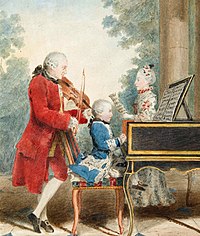This article includes a list of general references, but it lacks sufficient corresponding inline citations. (June 2023) |

| Major eras of Western classical music | ||||||||||||
|---|---|---|---|---|---|---|---|---|---|---|---|---|
| Early music | ||||||||||||
|
||||||||||||
| Common practice period | ||||||||||||
|
||||||||||||
| New music | ||||||||||||
|
||||||||||||
The Classical Period was an era of classical music between roughly 1750 and 1820.[1]
The classical period falls between the Baroque and Romantic periods.[2] Classical music has a lighter, clearer texture than Baroque music but a more varying use of musical form, which is, in simpler terms, the rhythm and organization of any given piece of music. It is mainly homophonic, using a clear melody line over a subordinate chordal accompaniment,[3] but counterpoint was by no means forgotten, especially in liturgical vocal music and, later in the period, secular instrumental music. It also makes use of style galant which emphasizes light elegance in place of the Baroque's dignified seriousness and impressive grandeur. Variety and contrast within a piece became more pronounced than before, and the orchestra increased in size, range, and power.
The harpsichord was replaced as the main keyboard instrument by the piano (or fortepiano). Unlike the harpsichord, which plucks strings with quills, pianos strike the strings with leather-covered hammers when the keys are pressed, which enables the performer to play louder or softer (hence the original name "fortepiano," literally "loud soft") and play with more expression; in contrast, the force with which a performer plays the harpsichord keys does not change the sound. Instrumental music was considered important by Classical period composers. The main kinds of instrumental music were the sonata, trio, string quartet, quintet, symphony (performed by an orchestra), and the solo concerto, which featured a virtuoso solo performer playing a solo work for violin, piano, flute, or another instrument, accompanied by an orchestra. Vocal music, such as songs for a singer and piano (notably the work of Schubert), choral works, and opera (a staged dramatic work for singers and orchestra), was also important during this period.
The best-known composers from this period are Joseph Haydn, Wolfgang Amadeus Mozart, Ludwig van Beethoven, and Franz Schubert; other names in this period include: Carl Philipp Emanuel Bach, Johann Christian Bach, Luigi Boccherini, Domenico Cimarosa, Joseph Martin Kraus, Muzio Clementi, Christoph Willibald Gluck, Carl Ditters von Dittersdorf, André Grétry, Pierre-Alexandre Monsigny, Leopold Mozart, Michael Haydn, Giovanni Paisiello, Johann Baptist Wanhal, François-André Danican Philidor, Niccolò Piccinni, Antonio Salieri, Etienne Nicolas Mehul, Georg Christoph Wagenseil, Johann Simon Mayr, Georg Matthias Monn, Johann Gottlieb Graun, Carl Heinrich Graun, Franz Benda, Georg Anton Benda, Johann Georg Albrechtsberger, Mauro Giuliani, Christian Cannabich and the Chevalier de Saint-Georges. Beethoven is regarded either as a Romantic composer or a Classical period composer who was part of the transition to the Romantic era. Schubert is also a transitional figure, as were Johann Nepomuk Hummel, Luigi Cherubini, Gaspare Spontini, Gioachino Rossini, Carl Maria von Weber, Jan Ladislav Dussek and Niccolò Paganini. The period is sometimes referred to as the era of Viennese Classicism (German: Wiener Klassik), since Gluck, Haydn, Salieri, Mozart, Beethoven, and Schubert all worked in Vienna.
- ^ Burton, Anthony (2002). A Performer's Guide to the Music of the Classical Period. London: Associated Board of the Royal Schools of Music. p. 3. ISBN 978-1-86096-1939.
- ^ AFSHARI, Faraz (2018). "A Comprehensive Study on Classical Music and Comparison with Other Music Styles, Types and Genres". IV International Vocational and Technical Sciences Congress – via ResearchGate.
- ^ Blume, Friedrich. Classic and Romantic Music: A Comprehensive Survey. New York: W. W. Norton, 1970